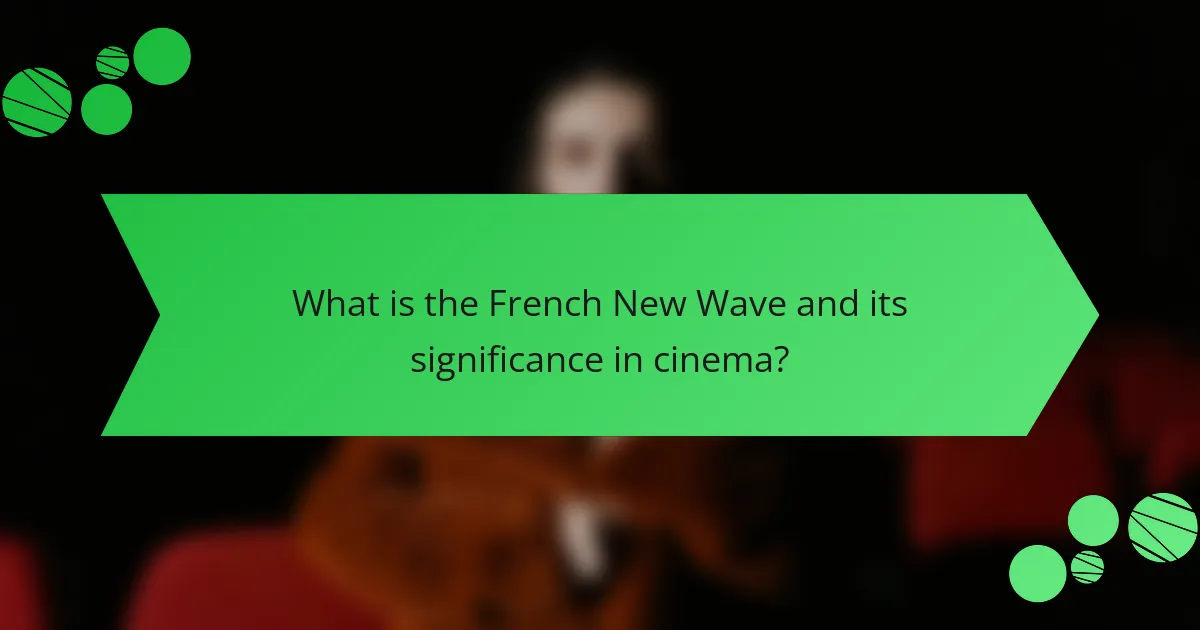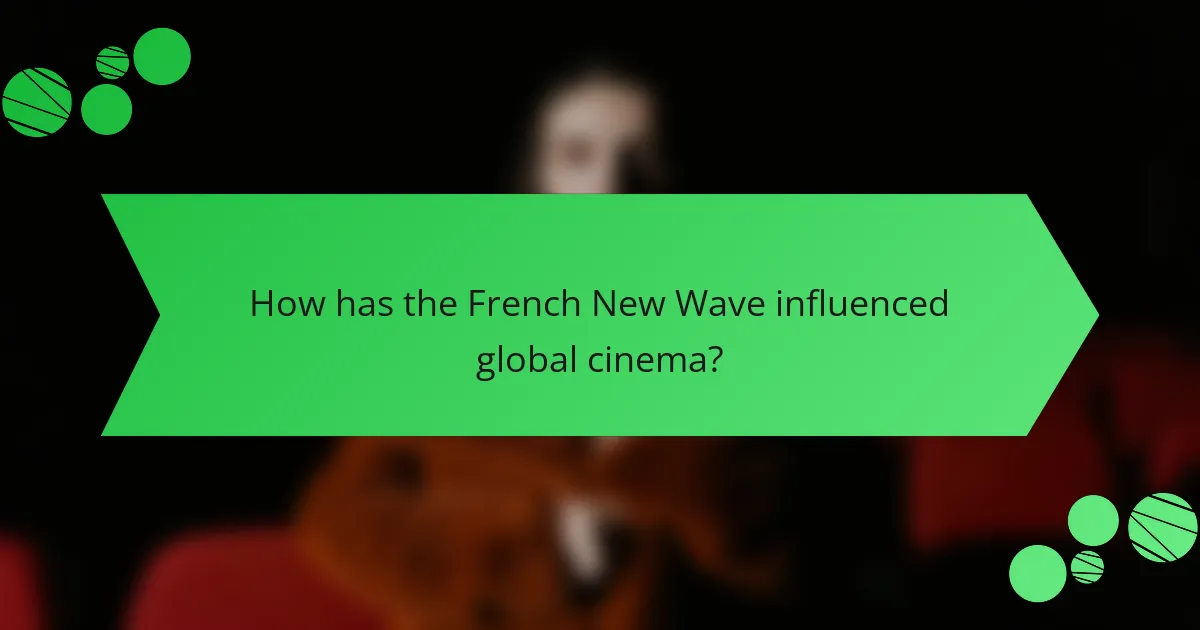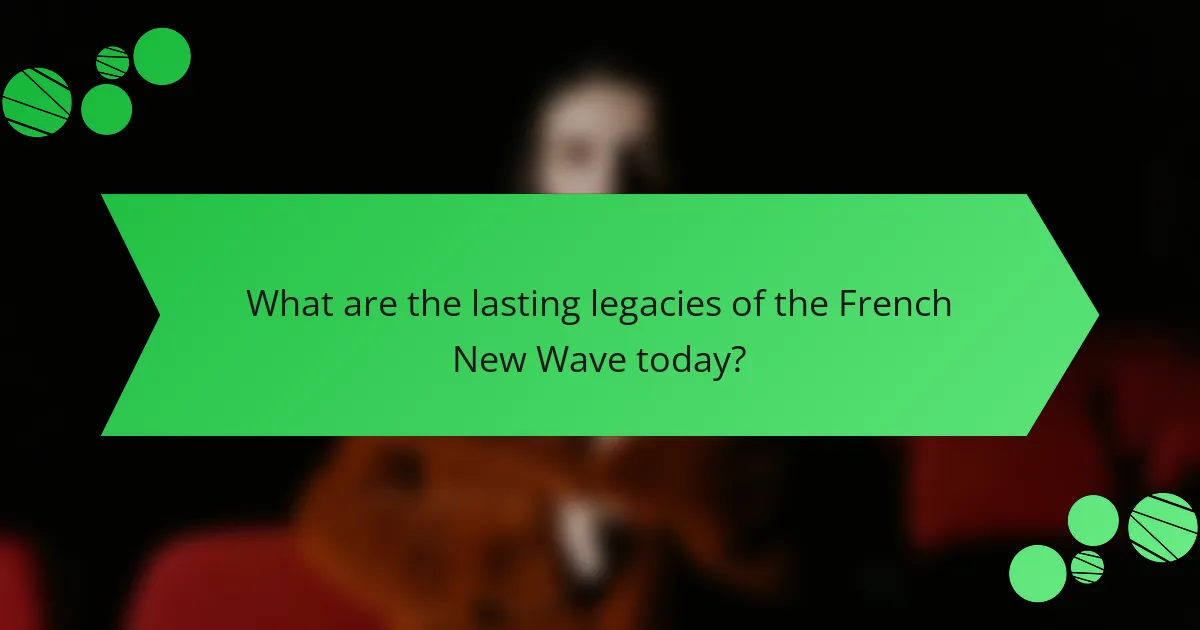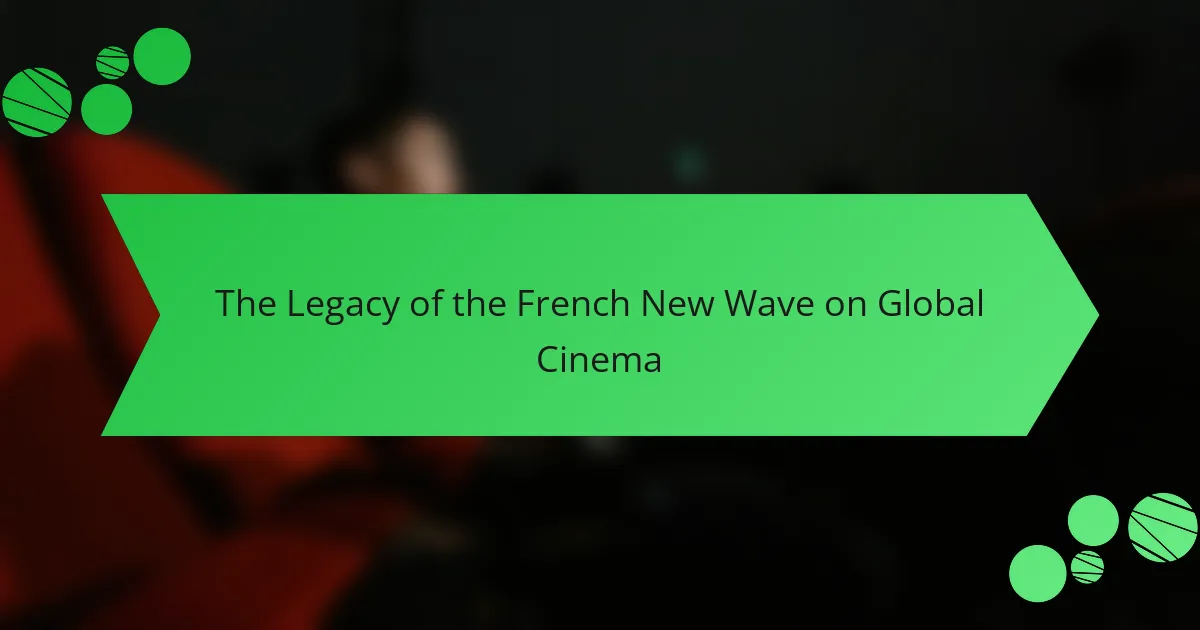
What is the French New Wave and its significance in cinema?
The French New Wave is a film movement that emerged in the late 1950s in France. It is characterized by its innovative techniques and a departure from traditional storytelling. Filmmakers like François Truffaut and Jean-Luc Godard played key roles in this movement. They emphasized personal expression and experimented with narrative structures. The movement challenged established cinematic norms and introduced new editing styles. It significantly influenced global cinema by inspiring filmmakers worldwide. The French New Wave’s impact can be seen in the rise of independent cinema and auteur theory. Its legacy continues to shape modern filmmaking practices today.
How did the French New Wave emerge as a movement?
The French New Wave emerged as a movement in the late 1950s. It originated from a group of young filmmakers who sought to challenge traditional cinematic conventions. Key figures included François Truffaut, Jean-Luc Godard, and Claude Chabrol. They were influenced by Italian Neorealism and sought to create a more personal, innovative style of filmmaking. The movement emphasized spontaneity, natural lighting, and on-location shooting. It also featured unconventional narratives and editing techniques. The emergence was marked by the release of films like “The 400 Blows” and “Breathless.” These films showcased a departure from established norms and resonated with audiences, paving the way for future cinematic innovation.
What cultural and historical contexts influenced the French New Wave?
The French New Wave was influenced by cultural and historical contexts such as post-World War II disillusionment. The war had left a profound impact on French society, fostering a desire for new artistic expressions. The rise of youth culture in the 1950s also played a crucial role. Young filmmakers sought to break away from traditional cinematic conventions. The influence of Italian Neorealism inspired a focus on realism and everyday life. Additionally, the advent of portable cameras allowed for more spontaneous filmmaking. The cultural shift towards personal storytelling emerged as a response to the rigid structures of classical cinema. These contexts collectively shaped the innovative techniques and themes of the French New Wave.
Who were the key figures behind the French New Wave?
The key figures behind the French New Wave include François Truffaut, Jean-Luc Godard, and Claude Chabrol. François Truffaut directed influential films such as “The 400 Blows,” which showcased innovative storytelling techniques. Jean-Luc Godard’s “Breathless” introduced a new style of editing and narrative structure. Claude Chabrol is known for his contributions to suspense and psychological drama within the movement. Other notable figures include Éric Rohmer and Jacques Rivette. These directors collectively challenged traditional filmmaking conventions. Their work significantly influenced global cinema, inspiring future filmmakers worldwide.
What are the defining characteristics of the French New Wave films?
French New Wave films are characterized by their innovative storytelling and stylistic experimentation. These films often feature non-linear narratives and a focus on character over plot. Directors employed techniques such as jump cuts, handheld camera work, and natural lighting. Many films included self-referential elements, breaking the fourth wall. The movement emphasized personal expression and artistic freedom. Key figures like François Truffaut and Jean-Luc Godard were instrumental in this style. The French New Wave emerged in the late 1950s and influenced global cinema profoundly. Its impact can be seen in the works of contemporary filmmakers who adopt similar techniques.
How did narrative techniques evolve in French New Wave cinema?
Narrative techniques in French New Wave cinema evolved significantly from traditional storytelling methods. Filmmakers like François Truffaut and Jean-Luc Godard challenged conventional plot structures. They employed jump cuts, breaking continuity to create a sense of spontaneity. This technique was evident in Godard’s “Breathless,” released in 1960. Additionally, filmmakers often used non-linear storytelling, which allowed for fragmented narratives. The use of direct address to the audience became common, further breaking the fourth wall. These innovations reflected a desire to capture the immediacy of life and personal expression. The French New Wave’s influence can be seen in global cinema, inspiring directors to experiment with narrative forms.
What visual styles are prominent in French New Wave films?
French New Wave films prominently feature innovative visual styles. These films often utilize handheld cameras for a more spontaneous feel. Jump cuts are a signature editing technique, creating a sense of urgency and realism. Natural lighting is frequently employed, enhancing authenticity in scenes. Locations are often shot on-site, capturing the essence of everyday life. Close-ups are used to emphasize emotional depth in characters. The use of unconventional narrative structures challenges traditional storytelling. These styles collectively influence contemporary filmmakers globally, showcasing the movement’s lasting impact.

How has the French New Wave influenced global cinema?
The French New Wave has significantly influenced global cinema through its innovative storytelling and stylistic techniques. This movement introduced concepts like jump cuts and breaking the fourth wall. Directors such as François Truffaut and Jean-Luc Godard emphasized personal expression and experimental narratives. Their work inspired filmmakers worldwide to challenge traditional filmmaking norms. The movement also championed the idea of the auteur, where directors are seen as the primary creative force behind films. This perspective has shaped modern cinema, encouraging unique voices and diverse storytelling. The impact of the French New Wave can be seen in various international films that adopt its techniques and philosophies.
What are the key impacts of the French New Wave on filmmaking techniques worldwide?
The French New Wave significantly impacted filmmaking techniques worldwide. It introduced innovative narrative structures that broke traditional storytelling. Filmmakers began using jump cuts, which created a sense of urgency and spontaneity. The movement emphasized location shooting, moving away from studios to capture authentic settings. Directors like François Truffaut and Jean-Luc Godard popularized the use of handheld cameras for a more personal perspective. Additionally, the French New Wave encouraged improvisation, allowing actors greater freedom in their performances. This shift influenced global cinema, inspiring movements such as the American independent film scene in the 1980s. The techniques established by the French New Wave continue to resonate in contemporary filmmaking.
How have editing styles from the French New Wave been adopted globally?
Editing styles from the French New Wave have been widely adopted in global cinema. Techniques such as jump cuts, non-linear storytelling, and breaking the fourth wall became influential. Filmmakers in various countries began incorporating these methods to create innovative narratives. For example, directors like Quentin Tarantino and Sofia Coppola have cited French New Wave influences in their works. The aesthetic of spontaneity and realism has also resonated with filmmakers in Asia and Latin America. Festivals celebrating independent cinema often showcase films that reflect these editing styles. This global adoption highlights the enduring impact of the French New Wave on contemporary filmmaking practices.
What narrative structures from the French New Wave have become mainstream?
Non-linear storytelling is a narrative structure from the French New Wave that has become mainstream. This approach often features fragmented timelines and disjointed sequences. Films like “Breathless” by Jean-Luc Godard exemplify this style. Another structure is the use of jump cuts, which disrupts continuity for artistic effect. This technique gained popularity in various genres, including action and drama. Additionally, self-reflexivity emerged, where films acknowledge their own construction. This has influenced many contemporary filmmakers. The blending of genres is also a notable legacy, allowing for more hybrid storytelling. These structures have shaped modern cinema significantly.
Which filmmakers have been inspired by the French New Wave?
Many filmmakers have been inspired by the French New Wave. Notable examples include Martin Scorsese, who adopted its innovative editing techniques. Quentin Tarantino is another filmmaker influenced by the movement’s narrative style. Sofia Coppola has also cited French New Wave aesthetics in her work. Directors like Wong Kar-wai and Pedro Almodóvar incorporate its themes of personal identity. The French New Wave’s impact is evident in their storytelling and visual styles. These filmmakers demonstrate the lasting legacy of the movement in contemporary cinema.
How have directors from different countries incorporated French New Wave elements?
Directors from various countries have incorporated French New Wave elements through innovative storytelling and stylistic techniques. For example, filmmakers in the United States adopted jump cuts and non-linear narratives, reminiscent of Jean-Luc Godard’s works. In Latin America, directors like Alejandro González Iñárritu embraced existential themes and character-driven plots, echoing the introspective nature of French New Wave cinema.
Asian filmmakers, such as Wong Kar-wai, utilized fragmented storytelling and a focus on personal relationships, drawing inspiration from the emotional depth found in French New Wave films. Additionally, European directors, including those from Italy, have blended social commentary with a playful approach to narrative structure, reflecting the influence of the French New Wave’s challenge to cinematic conventions.
These adaptations showcase the global reach of French New Wave aesthetics and its impact on diverse film industries. The incorporation of such elements has led to a richer, more varied cinematic landscape worldwide.
What specific films exemplify this influence in contemporary cinema?
“Breathless” (1960) exemplifies the influence of the French New Wave on contemporary cinema. This film, directed by Jean-Luc Godard, introduced innovative storytelling techniques. It featured jump cuts and a lack of traditional narrative structure. “The 400 Blows” (1959) by François Truffaut also had a significant impact. It showcased a more personal and autobiographical approach to filmmaking. “La Haine” (1995) reflects the social realism rooted in the New Wave tradition. This film addresses urban issues and youth disillusionment. “Amélie” (2001) incorporates whimsical storytelling, influenced by New Wave aesthetics. These films illustrate the lasting impact of the French New Wave on global cinema.

What are the lasting legacies of the French New Wave today?
The lasting legacies of the French New Wave today include innovative storytelling techniques and a focus on character-driven narratives. These films often feature non-linear plots and break traditional cinematic conventions. The movement popularized the use of jump cuts, which are now widely used in contemporary editing. Additionally, it emphasized the importance of personal expression in filmmaking. Directors like François Truffaut and Jean-Luc Godard inspired future filmmakers to explore their unique voices. The French New Wave also encouraged the use of real locations, which added authenticity to films. Its influence is evident in various genres, including independent and art-house cinema. Overall, the French New Wave reshaped the landscape of global cinema, promoting creativity and experimentation.
How does the French New Wave continue to shape modern film festivals?
The French New Wave significantly influences modern film festivals through its emphasis on innovation and auteur theory. This movement, which emerged in the late 1950s, prioritized personal expression and narrative experimentation. Modern film festivals celebrate diverse storytelling and unconventional techniques, reflecting the French New Wave’s legacy.
For instance, festivals like Cannes and Sundance showcase films that challenge traditional cinematic norms. They often feature works from emerging filmmakers, echoing the French New Wave’s focus on new voices. Additionally, the use of handheld cameras and natural lighting in contemporary films traces back to the techniques popularized by this movement.
The French New Wave also inspired the rise of independent cinema, which is a staple at many film festivals today. This shift towards independent and international films continues to shape programming and audience expectations. Overall, the French New Wave’s impact is evident in the ongoing celebration of creativity and originality at film festivals worldwide.
What role does the French New Wave play in film education and criticism?
The French New Wave significantly influences film education and criticism. It introduced innovative storytelling techniques and a focus on personal expression. Educators use its principles to teach cinematic language and narrative structure. The movement emphasized the director’s vision, shaping how films are analyzed. Critics often reference its techniques to contextualize modern cinema. The French New Wave challenged traditional filmmaking norms, encouraging critical discourse. Its impact is evident in film studies curricula worldwide. This legacy fosters a deeper understanding of film as an art form.
What practical lessons can filmmakers learn from the French New Wave?
Filmmakers can learn several practical lessons from the French New Wave. First, they should embrace spontaneity and improvisation. This movement often used natural settings and real locations, enhancing authenticity. Second, filmmakers can experiment with narrative structure. The French New Wave frequently employed non-linear storytelling and fragmented plots. Third, they should prioritize character over plot. This approach focuses on the emotional journey of characters rather than a conventional storyline. Fourth, filmmakers can utilize innovative editing techniques. Jump cuts and unconventional transitions were hallmarks of this style. Lastly, filmmakers should strive for personal expression. Many directors in this movement infused their own experiences and viewpoints into their films. These lessons reflect the French New Wave’s impact on cinematic storytelling and techniques.
How can independent filmmakers apply French New Wave techniques in their projects?
Independent filmmakers can apply French New Wave techniques by embracing spontaneity and experimentation in their storytelling. They should prioritize character-driven narratives that focus on personal experiences. Filmmakers can use handheld cameras to create a sense of immediacy and intimacy. Non-linear storytelling can be employed to challenge traditional narrative structures.
Incorporating jump cuts can enhance the film’s rhythm and energy. Filmmakers may also utilize natural lighting and real locations to maintain authenticity. Engaging in direct address to the audience can break the fourth wall, creating a unique viewing experience.
These techniques reflect the French New Wave’s emphasis on artistic freedom and innovation, which has influenced independent cinema globally.
What are the best practices for incorporating innovation in storytelling inspired by the French New Wave?
Incorporating innovation in storytelling inspired by the French New Wave involves embracing non-linear narratives. This technique allows for creative freedom and breaks traditional storytelling molds. Employing jump cuts enhances pacing and maintains viewer engagement. Utilizing real locations instead of sets adds authenticity to the narrative. Experimenting with character development fosters deeper emotional connections. Integrating self-reflexivity invites the audience to question the storytelling process. Additionally, blending genres can create unique narrative experiences. These best practices reflect the innovative spirit of the French New Wave, which transformed global cinema.
The French New Wave is a pivotal film movement that emerged in the late 1950s in France, characterized by innovative storytelling and a departure from traditional cinematic norms. Key figures such as François Truffaut and Jean-Luc Godard played significant roles in shaping this movement, which emphasized personal expression, non-linear narratives, and experimental editing techniques. The article explores the cultural and historical contexts that influenced the French New Wave, its defining characteristics, and its lasting impact on global cinema and contemporary filmmaking practices. Additionally, it highlights how filmmakers worldwide have adopted its techniques and the movement’s ongoing influence on film education, criticism, and festivals.
